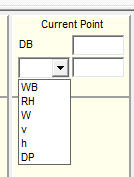HVAC Spreadsheet Calculations and Free Psychrometric Software
John Andrew, P.E.
Course Outline
This 3 PDH Professional Development Hour course includes a series of input data and solved output equations in an Excel format. The student will type numerical parameters and Excel will perform the calculations.
Results calculated in an Excel spreadsheet cell may be adjusted to a, “What If” value using, “Goal Seek”.
A links are provided to completely free: “Psychrometric Chart Software” and “Degree Day” downloads.
Subject matter is divided into nine worksheets:
1. Introduction
2. Cooling
3. Cooling Load
4. Heating Example
5. Heating Problem Solver
6. HVAC Ducting
7. Degree Day Calculatior
8. Unit Converter

The course includes
a multiple-choice quiz at the end, which is designed to enhance the understanding
of the course materials.
Learning Objective
At the conclusion of this course the student will:
- Have a spread sheet useful for HVAC calculations;
- Determine building cooling and heating loads that meet design specifications;
- Document design calculations in a spread sheet format;
- Convert common metric and U.S. units;
- Download a free Psychrometric Chart Software;
- Download a free Degree Day Software;
- Calculate HVAC US to Metric units and vise versa automatically;
- Calculate: humidity ratio, enthalpy, and all other air properties;
- Determine cooling and heating loads;
- Add thermal resistances in a spreadsheet:
- Find heat flow through floor slab on ground;
- Calculate air duct sizes and pressure drops;
- Make spreadsheet calculations based on input data and
- Use Excel to make, “what if calculations” using, "Goal Seek".
Intended Audience
The information will be especially useful to: students, engineers, and innovators who need tools for creative heating, ventilating, and cooling engineering calculations.
Benefit to Attendees
Attendee of this course will be able to calculate and optimize variables in a useful range HVAC engineering projects.
Course Introduction
Excel spread sheets are used in this course to calculate and optimize HVAC parameters. Spread sheets can be stored indefinitely and accessed electronically. Optimizing design values with spreadsheets is very convenient and is often more accurate than hand calculations.
Previously calculations have been done with a calculator and written by hand with pen or pencil. Optimizing design values with a calculator is difficult and time consuming. Quite often it is impossible to read and check these documents. As time passes sometime these documents are lost or are difficult to read.
It becomes difficult to use these hand written often illegible documents to make improvements to existing designs. Spread sheets can be accessed quickly.
Course Content
AIR CONDITIONING AND PSYCHROMETRICS
Heat, ventilating and cooling calculations determine equipment capacity necessary to maintain a desirable environment in buildings in the United State's range of climates.
If the sizing is wrong problems such as insufficient cooling, insufficient moisture removal, and unnecessarily high electricity and gas bills.
Use of the psychrometric chart will determine the volume flow rates of air to be pushed into the ducting system and the sizing of the major system components.
The goal of air conditioning processes is to provide sufficient amount of fresh air at desirable temperature and humidity.
Outside air is taken in and must undergo one or several of the following processes:
You need to download and study the following spreadsheet:
HVAC Spreadsheet Calculations and Free Psychrometric Software
DISCLAMER: "This spreadsheet is provided for illustrative teaching purpose only, and is not intended for use in any specific project. Anyone making use of theinformation contained in this spreadsheet does so at his/her own risk and assumes any and all resulting liability arising therefrom."
The calculations within this live spreadsheet will facilitate the initial design and engineering of many types of process piping systems. When various factors are typed into the Input cells, Excel will calculate results automatically. In addition, the powerful tool, "Goal Seek" can be used to optimize each design Calculation.
Course Summary
This course provides Excel spread sheets to calculate a range of basic HVAC parameters. All variables can be adjusted to optimize design goals. Excel print-outs of design parameters and calculated results provide easy to read documentation for checking and future improvements.
Related Links
For additional technical information related to this subject, please visit the following websites:
Ref. Mechanical Engineering Reference Manual by M Lindburg
HVAC Terminology http://www.ageng.ndsu.nodak.edu/envr/psyc/2.HTM
Engineering Toolbox http://www.engineeringtoolbox.com/minor-loss-air-ducts-fittings-d_208.html
Excel tutorials can be found at: https://edu.gcfglobal.org/en/excel2016/
Quiz
Once you finish studying the above course content, you need to take a quiz to obtain the PDH credits.
DISCLAIMER: The materials contained in the online course are not intended as a representation or warranty on the part of PDH Center or any other person/organization named herein. The materials are for general information only. They are not a substitute for competent professional advice. Application of this information to a specific project should be reviewed by a registered architect and/or professional engineer/surveyor. Anyone making use of the information set forth herein does so at their own risk and assumes any and all resulting liability arising therefrom.
